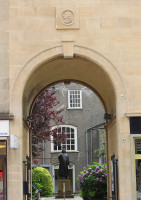
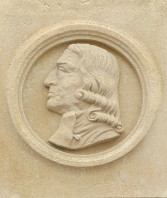 View of Wesley Chapel and statue through arch from Horsefair
View of Wesley Chapel and statue through arch from Horsefair

 View of Wesley Chapel and statue through arch from Horsefair
View of Wesley Chapel and statue through arch from Horsefair
Off Horsefair is a stone arch, which leads through to Wesley’s Chapel, the first Methodist chapel built, on land bought by Wesley himself in 1739. As well as the chapel below, on the first floor are the several rooms where Wesley himself resided, still decorated in 18th Century taste. There are two significant statues outside the building.
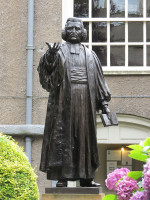 John Wesley statue by F. B. Hitch.
John Wesley statue by F. B. Hitch.
The statue of Wesley in the little courtyard shows the preacher standing, hand held out in oration, other hand holding his small open book, presumably the scripture from which he is declaiming. He is shown as a solid figure, different from the more usual depiction of Wesley as somewhat spare in build. He wears a long robe with heavy arms, over a lighter gown with a broad sash across his stomach. The rather sketchy treatment of the fabric and the general style places this statue in the mid 20th Century, and in fact it dates from 1939. The sculptor, Frederick Brook Hitch (1897-1957), made the notable Captain Matthew Flinders statue for Adelaide, Australia, and in England made a public statue of Nelson for Portsmouth. He was the son of the sculptor Nathaniel Hitch, whose work, if not name, is familiar in much eclesiastical sculpture in churches across England.
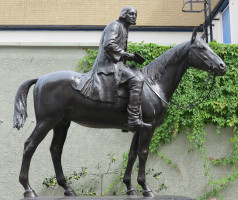
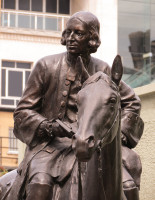 A. G. Walker's equestrian statue of Wesley.
A. G. Walker's equestrian statue of Wesley.
The second statue, on the other side of the Chapel, is an equestrian bronze of Wesley, and this portrait conforms rather more to the popular image of Wesley, as a rather thin, austere figure with high forehead and coiled hair or wig tight to the scalp. He wears a flamboyant coat, with broad turned-back sleeves and many large buttons, beneath which is a tunic, and his feet are shod with tall leathery boots. The pose has his neck and head somewhat thrust forward, giving a look of dynamism, and he grasps in one hand his open book. The other hand, against his side, holds his hat. The horse looks highly thoroughbred, the emphasis being on the smooth, sinuous neck. Arthur G. Walker was the accomplished sculptor of this work, and it too dates from the 1930s, though the beginning rather than the end of the decade.
Sculpture in England // Sculpture pages
Visits to this page from 22 Aug 2013: 6,755